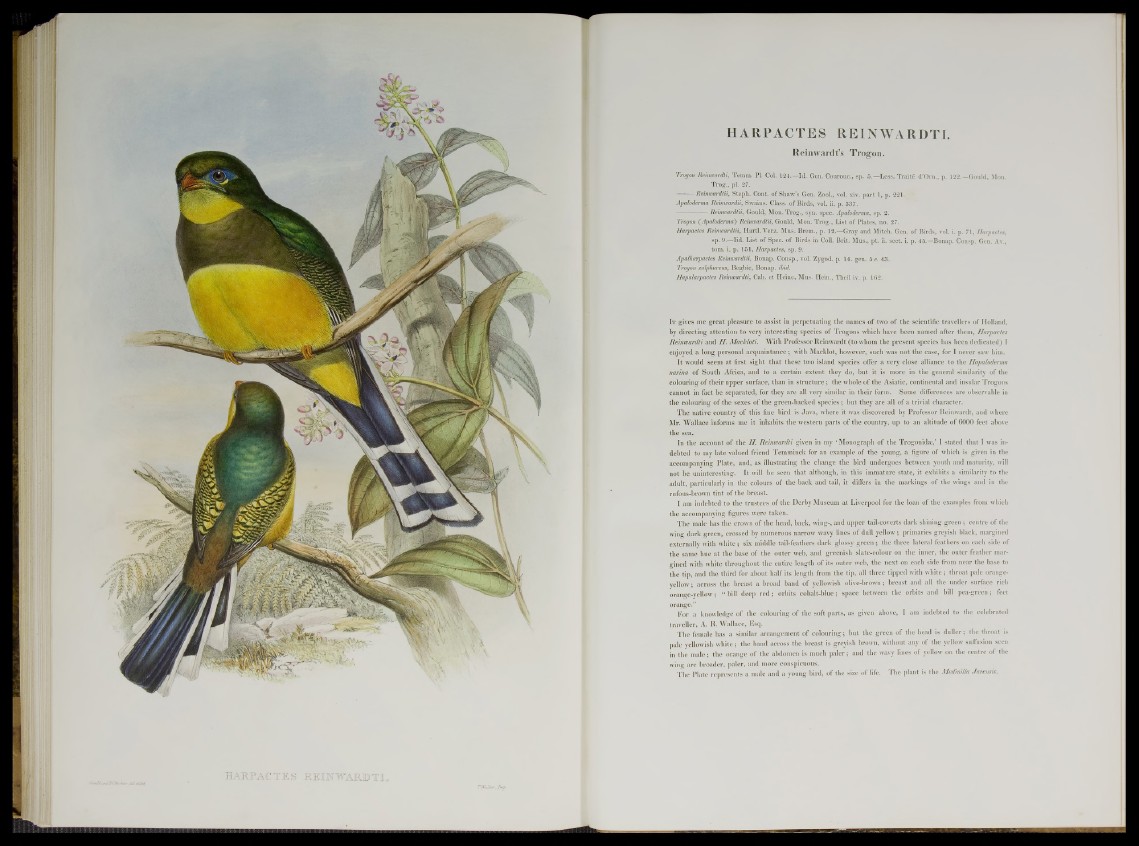
Reinwardt’s Trog*on.
Trogon Reinwardti, Temm. PL Gol. 124.—Id. Gen. Courouc., sp. 5 —Less. Traité d’Orn., p. 122.—Gould, Mon.
Trog., pi. 27.
— ■— Reinwardtii, Steph. Cont. of Shaw’s Gen. Zool., vol. xiv. p art 1, p. 221.
Apaloderma Reinwardii, Swains. Class, of Birds, vol. ii. p. 337.
-----------Reinwardtii, Gould, Mon. Trog., syn. spec. Apaloderma, sp. 2.
Trogon (Apaloderma) Reinwardtii, Gould, Mon. Trog., List of Plates, no. 27.
Harpactes Reinwardtii, Hartl. Verz. Mus. Brem., p. 12.—Gray and Mitch. Gen. of Birds, vol. i. p. 71, Harpactes,
sp. 9.—lid. List of Spec, of Birds in Coll. Brit. Mus., pt. ii. sect. i. p. 45.—Bonap. Consp. Gen. Av.,
tom. i. p. 151, Harpactes, sp. 9.
Apalharpactes Reinwardtii, Bonap. Consp., vol. Zygod. p. 14. gen. 5 e. 43.
Trogon sulphureus, Begbie, Bonap. ibid.
Hapalarpactes Reinwardti, Cab. et Heine, Mus. Hein., Theil iv. p. 162.
I t gives me great pleasure to assist in perpetuating the names of two of the scientific travellers of Holland,
by directing attention to very interesting species of Trogons which have been named after them, Harpactes
Reinwardti and H. Mack loti. With Professor Reinwardt (to whom the present species has been dedicated) I
enjoyed a long personal acquaintance; with Macklot, however, such was not the case, for I never saw him.
It would seem at first sight that these two island species offer a very close alliance to the Hapaloderma
narina of South Africa, and to a certain extent they do, but it is more in the general similarity of the
colouring of their upper surface, than in structure; the whole of the Asiatic, continental and insular Trogons
cannot in fact be separated, for they are all very similar in their form. Some differences are observable in
the colouring of the sexes of the green-backed species; but they are all of a trivial character.
The native country of this fine bird is Java, where it was discovered by Professor Reinwardt, and where
Mr. Wallace informs me it inhabits the western parts of the country, up to an altitude of 6000 feet above
the sea.
In the account of the H. Reinwardti given in my ‘ Monograph of the Trogonidae,’ I stated that I was indebted
to my late valued friend Temminck for an example of the young, a figure of which is given in the
accompanying Plate, and, as illustrating the change the bird undergoes between youth and maturity, will
not be uninteresting. It will be seen that although, in this immature state, it exhibits a similarity to the
adult, particularly in the colours of the back and tail, it differs in the markings of the wings and in the
rufous-brown tint of the breast.
I am indebted to the .trustees of the Derby Museum at Liverpool for the loan of the examples from which
the accompanying figures were taken.
The male has the crown of the head, back, wing-, and upper tail-coverts dark shining green; centre of the
win«- dark green, crossed by numerous narrow wavy lines of dull yellow; primaries greyish black, margined
externally with white; six middle tail-feathers dark glossy green; the three lateral feathers on each side of
the same hue at the base of the outer web, and greenish slate-colour on the inner, the outer feather mar-
o-ined with white throughout the entire length of its outer web, the next on each side from near the base to
the tip, and the third for about half its length from the tip, all three tipped with white; throat pale orange-
yellow ; across the breast a broad band of yellowish olive-brown; breast and all the under surface rich
orange-yellow; “ bill deep red; orbits cobalt-blue; space between the orbits and bill pea-green; feet
orange.”
For a knowledge of the colouring of the soft parts, as given above, I am indebted to the celebrated
traveller, A. R. Wallace, Esq.
The female has a similar arrangement of colouring; but the green of the head is duller; the throat is
pale yellowish white; the band across the breast is greyish brown, without any of the yellow suffusion seen
in the male; the orange of the abdomen is much paler; and the wavy lines of yellow on the centre of the
wing are broader, paler, and more conspicuous.
The Plate represents a male and a young bird, of the size of life. The plant is the Medinilla Javensis.